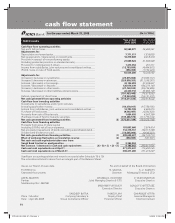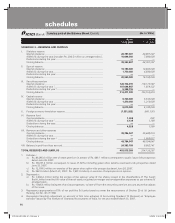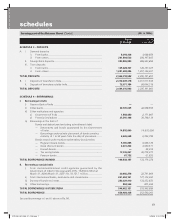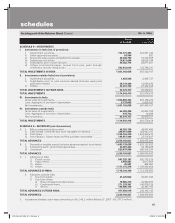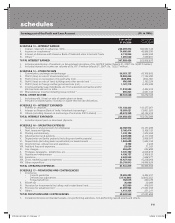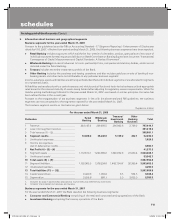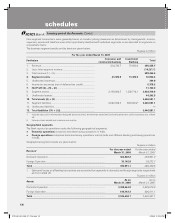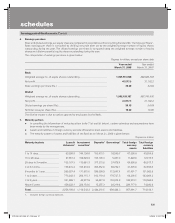ICICI Bank 2008 Annual Report Download - page 87
Download and view the complete annual report
Please find page 87 of the 2008 ICICI Bank annual report below. You can navigate through the pages in the report by either clicking on the pages listed below, or by using the keyword search tool below to find specific information within the annual report.
F13
and Derivatives Association. The valuation of other unquoted fixed income securities wherever linked to the Yield-to-
Maturity (“YTM”) rates, is computed with a mark-up (reflecting associated credit risk) over the YTM rates for government
securities published by Fixed Income Money Market and Derivatives Association.
Unquoted equity shares are valued at the break-up value, if the latest balance sheet is available, or at Re. 1, as per RBI
guidelines.
Securities are valued scrip-wise and depreciation/appreciation is aggregated for each category. Net appreciation in
each category, if any, being unrealised, is ignored, while net depreciation is provided for.
d) Costs including brokerage and commission pertaining to investments, paid at the time of acquisition, are charged to
the profit and loss account.
e) Equity investments in subsidiaries/joint ventures are categorised as ‘Held to Maturity’ in accordance with RBI
guidelines.
f) Profit on sale of investments in the ‘Held to Maturity’ category is credited to the profit and loss account and is thereafter
appropriated (net of applicable taxes and statutory reserve requirements) to Capital Reserve. Profit on sale of investments
in ‘Available for Sale’ and ‘Held for Trading’ categories is credited to profit and loss account.
g) Repurchase and reverse repurchase transactions are accounted for in accordance with the extant RBI guidelines.
h) Broken period interest on debt instruments is treated as a revenue item.
i) At the end of each reporting period, security receipts issued by the asset reconstruction company are valued in
accordance with the guidelines applicable to such instruments, prescribed by RBI from time to time. Accordingly,
in cases where the cash flows from security receipts issued by the asset reconstruction company are limited to the
actual realisation of the financial assets assigned to the instruments in the concerned scheme, the Bank reckons the
net asset value obtained from the asset reconstruction company from time to time, for valuation of such investments
at each reporting year end.
j) The Bank follows trade date method for accounting of its investments.
3. Provisions/Write-offs on loans and other credit facilities
a) All credit exposures are classified as per RBI guidelines, into performing and non-performing assets (“NPAs”). Further,
NPAs are classified into sub-standard, doubtful and loss assets based on the criteria stipulated by RBI. In the case of
corporate loans, provisions are made for sub-standard and doubtful assets at rates prescribed by RBI. Loss assets
and the unsecured portion of doubtful assets are provided/written off as per the extant RBI guidelines. Provisions on
homogeneous retail loans, subject to minimum provisioning requirements of RBI, are assessed at a portfolio level on
the basis of days past due. The Bank holds specific provisions against non-performing loans, general provision against
performing loans and floating provisions. The assessment of incremental specific provisions is made after taking into
consideration all of the above. The specific provisions on retail loans held by the Bank are higher than the minimum
regulatory requirements.
b) For restructured/rescheduled assets, provision is made in accordance with the guidelines issued by RBI, which requires
a provision equal to the present value of the interest sacrifice to be made at the time of restructuring.
c) In the case of loan accounts classified as NPAs (other than those subjected to restructuring), the account is upgraded
to “standard” category if arrears of interest and principal are fully paid by the borrower.
In respect of non-performing loan accounts subjected to restructuring, the account is upgraded to standard only after
the specified period i.e., a period of one year after the date when first payment of interest or of principal, whichever
is earlier, falls due, subject to satisfactory performance of the account during the period.
d) Amounts recovered against debts written off in earlier years and provisions no longer considered necessary in the
context of the current status of the borrower are recognised in the profit and loss account.
e) In addition to the specific provision on NPAs, the Bank maintains a general provision on performing loans. The general
provision covers the requirements of the RBI guidelines.
f) In addition to the provisions required to be held according to the asset classification status, provisions are held for
individual country exposures (other than for home country exposure). The countries are categorised into seven risk
categories namely insignificant, low, moderate, high, very high, restricted and off-credit and provisioning is made on
exposures exceeding 180 days on a graded scale ranging from 0.25% to 100%. For exposures with contractual maturity
of less than 180 days, 25% of the above provision is required to be held. If the country exposure (net) of the Bank
in respect of each country does not exceed 1% of the total funded assets, no provision is required on such country
exposure.
4. Transfer and servicing of assets
The Bank transfers commercial and consumer loans through securitisation transactions. The transferred loans are
de-recognised and gains/losses are accounted for only if the Bank surrenders the rights to benefits specified in the loan
contract. Recourse and servicing obligations are accounted for net of provisions.
schedules
forming part of the Accounts (Contd.)
ICICI_BK_AR_2008_(F1_F46).indd 13ICICI_BK_AR_2008_(F1_F46).indd 13 6/20/08 3:24:32 PM6/20/08 3:24:32 PM



